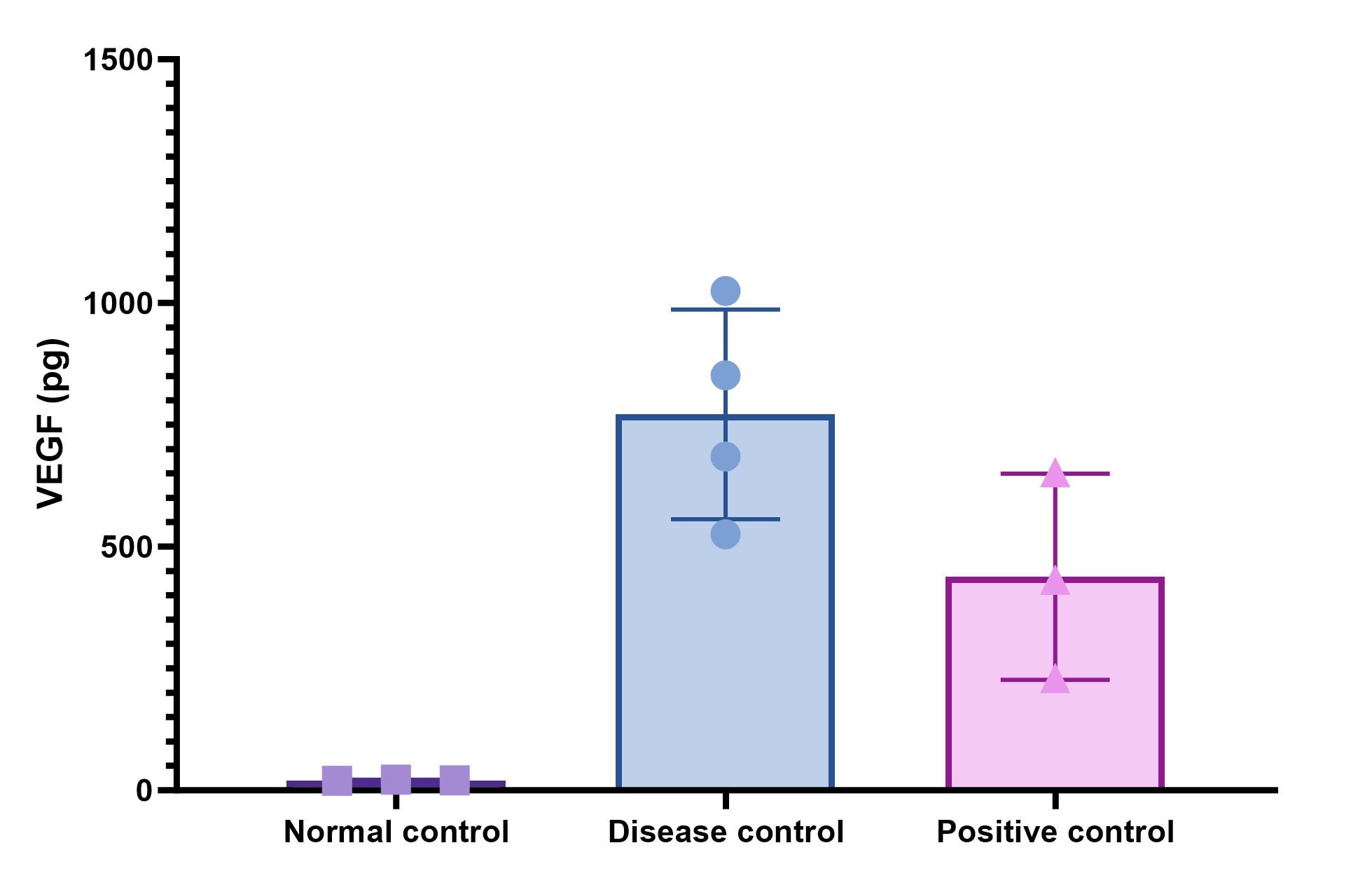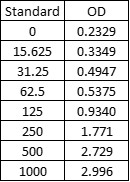Rat VEGF DuoSet ELISA Summary
* Provided that the recommended microplates, buffers, diluents, substrates and solutions are used, and the assay is run as summarized in the Assay Procedure provided.
This DuoSet ELISA Development kit contains the basic components required for the development of sandwich ELISAs to measure natural and recombinant rat VEGF. The suggested diluent is suitable for the analysis of most cell culture supernate samples. Diluents for complex matrices, such as serum and plasma, should be evaluated prior to use in this DuoSet.
Product Features
- Optimized capture and detection antibody pairings with recommended concentrations save lengthy development time
- Development protocols are provided to guide further assay optimization
- Assay can be customized to your specific needs
- Economical alternative to complete kits
Kit Content
- Capture Antibody
- Detection Antibody
- Recombinant Standard
- Streptavidin conjugated to horseradish-peroxidase (Streptavidin-HRP)
Other Reagents Required
DuoSet Ancillary Reagent Kit 2 (5 plates): (Catalog # DY008) containing 96 well microplates, plate sealers, substrate solution, stop solution, plate coating buffer (PBS), wash buffer, and Reagent Diluent Concentrate 2.
The components listed above may be purchased separately:
PBS: (Catalog # DY006), or 137 mM NaCl, 2.7 mM KCl, 8.1 mM Na2HPO4, 1.5 mM KH2PO4, pH 7.2 - 7.4, 0.2 µm filtered
Wash Buffer: (Catalog # WA126), or 0.05% Tween® 20 in PBS, pH 7.2-7.4
Reagent Diluent: (Catalog # DY995), or 1% BSA in PBS, pH 7.2-7.4, 0.2 µm filtered
Substrate Solution: 1:1 mixture of Color Reagent A (H2O2) and Color Reagent B (Tetramethylbenzidine) (Catalog # DY999)
Stop Solution: 2 N H2SO4 (Catalog # DY994)
Microplates: R&D Systems (Catalog # DY990)
Plate Sealers: ELISA Plate Sealers (Catalog # DY992)
Scientific Data
Product Datasheets
Preparation and Storage
Background: VEGF
Vascular endothelial growth factor (VEGF or VEGF-A), also known as vascular permeability factor (VPF), is a potent mediator of both angiogenesis and vasculogenesis in the fetus and in adults (1-3). It is a member of the PDGF family that is characterized by the presence of eight conserved cysteine residues in a cystine knot structure and formation of anti-parallel disulfide-linked dimers (4). Alternately spliced isoforms of 120, 164, and 188 amino acids (aa) have been found in rats and mice, while 121, 145, 165, 183, 189, and 206 aa isoforms have been identified in humans (2, 4). In humans, VEGF165 appears to be the most abundant and potent isoform, followed by VEGF121 and VEGF189 (3, 4). The same pattern may exist in rats and mice. Isoforms other than VEGF120 and VEGF121 contain basic heparin-binding regions and are not freely diffusible (4). Rat VEGF164 shares 97% aa sequence identity with corresponding regions of mouse, 88% with human and bovine, 89% with porcine and canine, and 90% with feline and equine VEGF. VEGF is expressed in multiple cells and tissues including skeletal and cardiac muscle (5, 6), hepatocytes (7), osteoblasts (8), neutrophils (9), macrophages (10), keratinocytes (11), brown adipose tissue (12), CD34+ stem cells (13), endothelial cells (14), fibroblasts, and vascular smooth muscle cells (15). VEGF expression is induced by hypoxia and cytokines such as IL-1, IL-6, IL-8, Oncostatin M, and TNF-alpha (3, 4, 9). The isoforms are differentially expressed during development and in the adult (3).
Assay Procedure
GENERAL ELISA PROTOCOL
Plate Preparation
- Dilute the Capture Antibody to the working concentration in PBS without carrier protein. Immediately coat a 96-well microplate with 100 μL per well of the diluted Capture Antibody. Seal the plate and incubate overnight at room temperature.
- Aspirate each well and wash with Wash Buffer, repeating the process two times for a total of three washes. Wash by filling each well with Wash Buffer (400 μL) using a squirt bottle, manifold dispenser, or autowasher. Complete removal of liquid at each step is essential for good performance. After the last wash, remove any remaining Wash Buffer by aspirating or by inverting the plate and blotting it against clean paper towels.
- Block plates by adding 300 μL Reagent Diluent to each well. Incubate at room temperature for a minimum of 1 hour.
- Repeat the aspiration/wash as in step 2. The plates are now ready for sample addition.
Assay Procedure
- Add 100 μL of sample or standards in Reagent Diluent, or an appropriate diluent, per well. Cover with an adhesive strip and incubate 2 hours at room temperature.
- Repeat the aspiration/wash as in step 2 of Plate Preparation.
- Add 100 μL of the Detection Antibody, diluted in Reagent Diluent, to each well. Cover with a new adhesive strip and incubate 2 hours at room temperature.
- Repeat the aspiration/wash as in step 2 of Plate Preparation.
- Add 100 μL of the working dilution of Streptavidin-HRP to each well. Cover the plate and incubate for 20 minutes at room temperature. Avoid placing the plate in direct light.
- Repeat the aspiration/wash as in step 2.
- Add 100 μL of Substrate Solution to each well. Incubate for 20 minutes at room temperature. Avoid placing the plate in direct light.
- Add 50 μL of Stop Solution to each well. Gently tap the plate to ensure thorough mixing.
- Determine the optical density of each well immediately, using a microplate reader set to 450 nm. If wavelength correction is available, set to 540 nm or 570 nm. If wavelength correction is not available, subtract readings at 540 nm or 570 nm from the readings at 450 nm. This subtraction will correct for optical imperfections in the plate. Readings made directly at 450 nm without correction may be higher and less accurate.
Citations for Rat VEGF DuoSet ELISA
R&D Systems personnel manually curate a database that contains references using R&D Systems products. The data collected includes not only links to publications in PubMed, but also provides information about sample types, species, and experimental conditions.
17
Citations: Showing 1 - 10
Filter your results:
Filter by:
-
Sustained release of vascular endothelial growth factor A and basic fibroblast growth factor from nanofiber membranes reduces oxygen/glucose deprivation-induced injury to neurovascular units
Authors: Wu, Y;Sun, J;Lin, Q;Wang, D;Hai, J;
Neural regeneration research
-
Foraging for the Optimal Dressing Scaffold to Carry Adipose-Derived Stromal/Progenitor Cells for Cell Therapy
Authors: CC Wu, YC Chen, YC Wu, SH Huang, YR Kuo, SS Lee
Oncogene, 2022-01-01;31(0):9636897221113.
Species: Rat
Sample Types: Cell Culture Supernates
-
Therapeutic Effects of Fenofibrate Nano-Emulsion Eye Drops on Retinal Vascular Leakage and Neovascularization
Authors: L Huang, W Liang, K Zhou, RA Wassel, ZD Ridge, JX Ma, B Wang
Biology, 2021-12-15;10(12):.
Species: Rat
Sample Types: Tissue Homogenates
-
Neuroprotective Effects of VEGF-A Nanofiber Membrane and FAAH Inhibitor URB597 Against Oxygen-Glucose Deprivation-Induced Ischemic Neuronal Injury
Authors: DP Wang, KY Jin, P Zhao, Q Lin, K Kang, J Hai
International Journal of Nanomedicine, 2021-05-27;16(0):3661-3678.
Species: Rat
Sample Types: Nanofibers
-
Heparin-conjugated collagen as a potent growth factor-localizing and stabilizing scaffold for regenerative medicine
Authors: Y Ikegami, H Mizumachi, K Yoshida, H Ijima
Regenerative Therapy, 2020-11-01;15(0):236-242.
Species: Rat
Sample Types: Cell Culture Supernates
-
Bladder Regeneration Using a Polycaprolactone Scaffold with a Gradient Structure and Growth Factors in a Partially Cystectomized Rat Model
Authors: HY Kim, SY Chun, EH Lee, B Kim, YS Ha, JW Chung, JN Lee, BS Kim, SH Oh, TG Kwon
J Korean Med Sci, 2020-10-26;35(41):e374.
Species: Rat
Sample Types: Cell Culture Supernates
-
VEGF/Flk1 Mechanism is Involved in Roxarsone Promotion of Rat Endothelial Cell Growth and B16F10 Xenograft Tumor Angiogenesis
Authors: S Chen, J Xu, Q Wei, Z Zhao, X Chen, H Cui, Y Zhang
Sci Rep, 2019-11-22;9(1):17417.
Species: Rat
Sample Types: Cell Culture Supernates
-
Effects of lncRNA BANCR on endometriosis through ERK/MAPK pathway
Authors: MB Zhu, LP Chen, M Hu, Z Shi, YN Liu
Eur Rev Med Pharmacol Sci, 2019-08-01;23(16):6806-6812.
Species: Rat
Sample Types: Serum
-
Improvement of diabetic wound healing by topical application of Vicenin-2 hydrocolloid film on Sprague Dawley rats
Authors: WS Tan, P Arulselvan, SF Ng, CN Mat Taib, MN Sarian, S Fakurazi
BMC Complement Altern Med, 2019-01-17;19(1):20.
Species: Rat
Sample Types: Tissue Homogenates
-
Lifelong environmental enrichment in the absence of exercise protects the brain from age-related cognitive decline
Authors: AM Birch, ÁM Kelly
Neuropharmacology, 2018-04-07;0(0):.
Species: Rat
Sample Types: Tissue Culture Supernates
-
Nrf2 Activation Is a Potential Therapeutic Approach to Attenuate Diabetic Retinopathy
Authors: D Deliyanti, SF Alrashdi, SM Tan, C Meyer, KW Ward, JB de Haan, JL Wilkinson-
Invest. Ophthalmol. Vis. Sci., 2018-02-01;59(2):815-825.
Species: Rat
Sample Types: Cell Lysates
-
Albumin suppresses vascular endothelial growth factor via alteration of hypoxia-inducible factor/hypoxia-responsive element pathway.
Authors: Katavetin P, Inagi R, Miyata T, Tanaka T, Sassa R, Ingelfinger JR, Fujita T, Nangaku M
Biochem. Biophys. Res. Commun., 2007-12-26;367(2):305-10.
Species: Rat
Sample Types: Cell Culture Supernates
-
Transforming growth factor-beta1 enhanced vascular endothelial growth factor synthesis in mesenchymal stem cells.
Authors: Wang XJ, Dong Z, Zhong XH, Shi RZ, Huang SH, Lou Y, Li QP
Biochem. Biophys. Res. Commun., 2007-11-20;365(3):548-54.
Species: Rat
Sample Types: Cell Culture Supernates
-
Inhibition of angiogenesis by interleukin-4 gene therapy in rat adjuvant-induced arthritis.
Authors: Haas CS, Amin MA, Allen BB, Ruth JH, Haines GK, Woods JM, Koch AE
Arthritis Rheum., 2006-08-01;54(8):2402-14.
Species: Rat
Sample Types: Tissue Homogenates
-
Bone marrow molecular alterations after myocardial infarction: Impact on endothelial progenitor cells.
Authors: Thum T, Fraccarollo D, Galuppo P, Tsikas D, Frantz S, Ertl G, Bauersachs J
Cardiovasc. Res., 2006-02-09;70(1):50-60.
Species: Rat
Sample Types: Cell Lysates
-
Prophylactic adenovirus-mediated human kallistatin gene therapy suppresses rat arthritis by inhibiting angiogenesis and inflammation.
Authors: Wang CR, Chen SY, Wu CL, Liu MF, Jin YT, Chao L, Chao J
Arthritis Rheum., 2005-04-01;52(4):1319-24.
Species: Rat
Sample Types: Tissue Homogenates
-
Effect of tumor host microenvironment on photodynamic therapy in a rat prostate tumor model.
Authors: Chen B, Pogue BW, Zhou X, O'Hara JA, Solban N, Demidenko E, Hoopes PJ, Hasan T
Clin. Cancer Res., 2005-01-15;11(2):720-7.
Species: Rat
Sample Types: Cell Culture Supernates
FAQs
No product specific FAQs exist for this product, however you may
View all ELISA FAQsReviews for Rat VEGF DuoSet ELISA
Average Rating: 4.3 (Based on 3 Reviews)
Have you used Rat VEGF DuoSet ELISA?
Submit a review and receive an Amazon gift card.
$25/€18/£15/$25CAN/¥75 Yuan/¥2500 Yen for a review with an image
$10/€7/£6/$10 CAD/¥70 Yuan/¥1110 Yen for a review without an image
Filter by:








